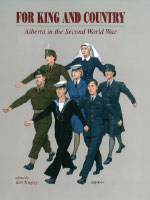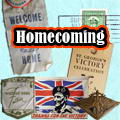The Japanese Balloon Bomb Assault on North America: An Alberta Perspective
N. Frank Chiovelli
Reprinted with permission of the author and publisher of For King and Country: Alberta in the Second World War The chandelier itself consisted of two aluminum rings held, one above the other, by four pillar-bolts mounted on a cross-brace attached to the inside of the larger lower ring. The large ring had 72 holes drilled into its horizontal edge, which were numbered in pairs 1 through 36. The bottom face of the ring had a thin channel cut through the entire circumference with a depth surpassing the horizontal holes. Rectangular suspension links with one hole drilled on each end were placed into the channel, and pinned in place by inserting explosive blow¬plugs through the horizontal holes. "S" hooks were then used to sling ballast bags or bombs from the suspension links.
The chandelier itself consisted of two aluminum rings held, one above the other, by four pillar-bolts mounted on a cross-brace attached to the inside of the larger lower ring. The large ring had 72 holes drilled into its horizontal edge, which were numbered in pairs 1 through 36. The bottom face of the ring had a thin channel cut through the entire circumference with a depth surpassing the horizontal holes. Rectangular suspension links with one hole drilled on each end were placed into the channel, and pinned in place by inserting explosive blow¬plugs through the horizontal holes. "S" hooks were then used to sling ballast bags or bombs from the suspension links.
The small ring had holes drilled horizontally, and these also were numbered in pairs from I through 36. These holes contained spring switches which were connected to matching pairs of blow-plugs in the lower ring by a safety fuse. Centered over the small ring, and attached by the pillar-bolts, was a bakelite disc with a rotating contact-switch which was controlled by four aeronoid barometers mounted in the false bottom of a wooden box. Attached to the top of the box was a celluloid container with a waterproof compartment containing a battery. Surrounding that was a space to contain water that served as a solar-heating device, which enabled the battery to function at the low temperatures encountered at high altitudes.
Two 33-foot safety fuses were wound around the wooden box and connected to blow-out plugs in position on the small ring. These fuses were ignited by friction igniters when the balloons were launched. Burning for about three quarters of an hour, they gave the balloon time to gain altitude. At this time, the blow-out plugs were fired, releasing a spring-switch which in turn activated an automatic-switching device.
Set to fly at an altitude of 30,000 feet, the balloon vented gas during the warm daylight hours. During the cooler night hours when losing altitude, the barometers would fire the blow-plugs, in turn dropping the ballast bags, providing lift to a now lighter craft. Calculated to give an estimated flight time of between three and five days, bomb loads were sequenced to drop near the end of the estimated flight paths.
Two "self destruct" charges were attached to many of the balloons. One of these was placed in a pocket near the catenary curtain. Sixty feet of fuse connected this charge to a casting attached to the cross-brace in the large ring. A T-hook in that casting was held in place by two blow-plugs; generally, a 32-kilogram high-explosive bomb was slung on this hook. When this bomb was dropped, the blow-plugs were designed to ignite the fuse leading to the envelope charge. A burn time of about one hour was required for this. When the envelope was destroyed, the automatic switches on the chandelier would then close as the mass dropped to 15,000 feet, setting off the second charge which was placed beside the battery box.6
Hardware and instruments for the balloon bombs were manufactured in Japanese factories. The paper balloon envelopes were made in large theatres and sumo wrestling halls, which allowed assembly and inflation-testing of the finished product on-site. Construction of the balloon envelopes was a labour¬intensive operation in which large numbers of high school students were employed.7
As the manufacture of balloons started, a new Army unit designated the "Special Balloon Regiment" was created. Comprised of three battalions, it was commanded by Colonel Inone. This regiment was to select and prepare three bases suitable as launch sites, to coordinate radio-tracking duties with the Army Weather Bureau, to set up gas-production facilities, and to train its personnel for launch duties.
When this project had reached its final stages, the Japanese government began to publicize the effort in an attempt to stiffen public support for the war. However, the military took great pains to erase any markings that could identify the balloon equipment as Japanese. There does not appear to have been any attempt to remove markings from the bomb load. This probably was a deliberate ploy to confuse victims and investigators regarding the means by which attacks were carried out. Of course this would be valid only if the self-destruct devices functioned as planned, which in fact they did not.8
After the attack on Pearl Harbor, the Canadian and US governments put together a joint defence plan using knowledge acquired from British and Canadian experience in the defence of the British Isles. Factored into these plans was secret work on chemical and bacteriological warfare that Canada and Britain had been conducting since the First World War. A defence strategy was put in place, based upon the premise that "if we have it - they have it." Directives to top-level officers and civilian personnel outlined military and civil defence measures, and imposed censorship regulations for the media. The entire North American west coast was prepared for an air attack from carrier-borne air raids. Preparations were made to defend the population against chemical or bacteriological attacks. Protection of the huge timber stands along the Pacific Coast was a major concern and was singled out as a priority item.9
T.P. Blefgen, Director of Forestry for the Province of Alberta, stated in a memorandum of 20 April 1942:
In connection with the fast approaching fire season and its relation to the entry of the Japanese into th0e world war, it is noted that the Forestry Branch of our neighboring Province to the West is extremely apprehensive of the possibility of "calling cards" in the form of inflammable leaflets being dropped in some of the west coast forests, and have warned their personnel to be on the lookout for any eventuality along these lines.
Blefgen went on to describe a raid of this type carried out by the RAF over the Black Forest in Germany, using small incendiary bombs, during the summer of 1941. He further stated that if such a campaign were initiated, a possible danger zone lay in the area of northern British Columbia and along the corridor of the Alaska Highway.10
Notes
6. Ibid; most of the technical information regarding the balloon bombs is taken from the McKay article.
7. Robert C. Mikesh, op. cit.
8. Ibid; Mikesh provides an excellent historical overview of the development of the balloon bomb campaign.
9. John Bryden, Deadly Allies Canada's Secret War 1937-1947 [McClelland & Stewart, 1988].
10. T.F. Blefgen, Director of Forestry, Province of Alberta, Memorandum dated: 20 April 1942; papers and other information regarding wartime forestry concerns were provided to the author by Peter J. Murphy, Associate Dean of Forestry, Faculty of Agriculture and Forestry, University of Alberta, on 21 August 1984.








